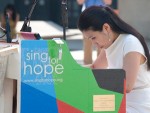Title
This summer, the New York City landscape was dotted with tourists, ice cream trucks, and pianos.
Body
From June 21 to July 5, the installation project Play Me, I’m Yours brought pianos—painted a rainbow of colors—to neighborhoods located in all five boroughs of the Big Apple. The instruments inspired classical performances and jam sessions alike. For some, the project provided a simple opportunity to connect with fellow musicians or to perform for the public. For many more, it was a rare chance to play a full-sized upright piano.
Created by the English artist Luke Jerram, Play Me, I’m Yours was first presented in Birmingham, England, in 2008 as a way to foster community, particularly among strangers living in the same neighborhoods. Since then, it has been presented in cities across the world, including São Paulo, Brazil; Sydney, Australia; and London. The nonprofit organization Sing for Hope, founded by Juilliard vocal arts alumni Camille Zamora and Monica Yunus, partnered with Jerram to present the installation in New York City. Officially established in 2006, Sing for Hope’s programs include arts education in underfunded schools, outreach and performance in hospitals, and community-based benefit concerts.
The 60 pianos placed throughout the city elicited puzzled yet pleased responses from passersby. Across the front of each instrument appeared the phrase “Play Me, I’m Yours,” while vibrant paint jobs—the work of volunteers, including students in Sing for Hope’s Art U! youth outreach program—distinguished each piano as a unique work of art. Sophie Matisse, the great-granddaughter of Henri Matisse, step-granddaughter of Marcel Duchamp, and an acclaimed artist herself, painted four pianos with sweeping lines and geometric patterns in deep colors. They were placed throughout Lincoln Center.
In a recent interview with The Journal, Jerram explained that the project’s title is more than just a play on words. “‘Play me’ sort of suggests that the piano has some personality,” he said. “Then, ‘I’m yours’ suggests a sense of ownership—this piano belongs to you and your community. And that’s important.”
That sense of community extended to the maintenance of the pianos as well. Tuning, repairs, and ongoing care was provided by a volunteer piano technician, Fred Patella, who also located the donated instruments. Individual pianos were watched over by neighborhood volunteers, or “piano buddies.” Following the installation, 48 pianos were donated to participating schools, community centers, and hospitals, while the remaining instruments were auctioned to benefit Sing for Hope’s programs.
In Brooklyn’s McCarren Park, Heath Winborn, 38, played a sunny yellow piano while his 2-year-old daughter Stella, clad in a sun hat and glasses, sat on his lap. Eerily beautiful chords floated forth, and several mid-morning strollers stopped to listen. Winborn explained that he used to have a piano but got rid of it because his family needed more space. However, he wanted his daughter to experience it in some way. “She really responds to music,” he said.
Juilliard alumnus Vadim Ghin first visited the Riverside Park location at 70th Street’s Pier 1, where two pianos sat back to back. He played Chopin’s “Minute” Waltz on one piano, then the other, while his wife, Kristen Child, filmed the performance. Inspired, Ghin decided to repeat the experiment at each and every Play Me, I’m Yours site, creating a continuous video montage of his performances, titled The New York Minute. As he sat down to play the piece at pianos across the five boroughs, Ghin was pleasantly surprised by the reactions of those around him. “It was an instant connection that everybody had,” he said. He contrasted the experience with a scenario familiar to many in the Juilliard community—putting on a tuxedo and waiting backstage before performing.
In fact, breaking down the boundaries between professional artists and the general public is exactly what Sing for Hope strives to do. Play Me, I’m Yours inspired endorsements by artists like Alicia Keys and Lauren Ambrose, and Ambrose performed at the Chelsea Market location with her band. An opening concert in Times Square featured various Broadway stars, while a closing event in Lincoln Center included performances by Juilliard alumna Joyce Yang and jazz pianist Eldar.
The root of the project, though, remained one of community. While expressing his admiration for the ambitious initiatives surrounding the installation, Jerram pointed to the central aim of Play Me, I’m Yours. “The project isn’t about celebrities playing pianos, or celebrities opening pianos, or anything,” he said. “It’s about [the] public playing pianos [for] their friends, about providing instruments to people who are trained in piano but don’t have a piano to play.”
At a buzzing Astor Place subway entrance, a young man in glasses, Michele Ceru, of Italy, nimbly raced through an interpretation of Chopin’s Ballade No. 3. Next, a trio of college-age girls in oversized sunglasses and summery outfits pounded out “Heart and Soul.” Emma Carone, a 22-year-old from Virginia, hadn’t heard of the street pianos. “Too bad they’re not here forever,” she said.
This seems to have been the resounding sentiment of all who came into contact with the installation. And the response has not gone unheard—Emily Walsh, Sing for Hope’s director of operations and a Juilliard dance alumna, confirmed that the organization has already begun planning the return of Play Me, I’m Yours in summer 2011.





